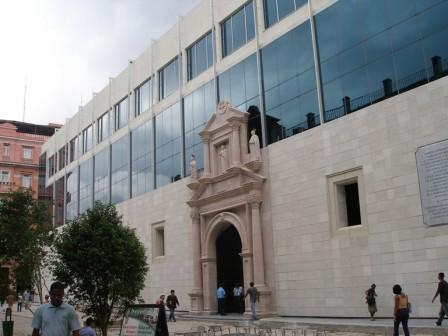Reflections of a Reflection in Old Havana

—During the years of the Batista dictatorship, somebody got the idea of constructing a building on which helicopters could land in the middle of Old Havana. In order to do so, they demolished an antique structure that had housed the University of Havana during its inception.
I remember when I was a child that each time we passed through this part of Havana my Dad would say to me: “Look, that’s a building where you can land helicopters.” My father’s remark seemed strange to me, since I had seen enough American movies to know that a helicopter can land anywhere. I didn’t know what a “heliport” was (the concept that motivated the architects): and I never saw any helicopters around the area. My Dad also would note that it was a square, modern and ugly building, and very atypical of that zone of the city. Nearby, there were some large bells and a headless statue.
During this era the Ministry of Education was located in that building. I went there to take my admissions examinations to the Lenin School, a pre-university program that I thought was the best in Cuba. Once in the Lenin school, I learned that it really wasn’t so, that there was another school that was even more elitist. Later I also found out that there were a ton of good people who hadn’t attended these elite pre-universities. And with time I forgot that important rite of passage that would always be associated in my mind with the helicopter building.

Many of us wondered what they would do with the building when there was finally enough money in the budget to seriously reconstruct the old city. That funding appeared more than a decade ago. The moment came when the Office of the City Historian, whose responsibilities included the protection of Havana’s historic patrimony, took charge of the now almost fifty-year old heliport.
They announced that the building would be covered with mirror glass so that it could insert itself “organically” into the architectonic surroundings. In that way, it would be reflecting the esthetics of the old buildings surrounding it, its ugliness disguised by the magic of the spectacular images.
They removed the headless statue and constructed a bell-tower for the bells, made to resemble the one that the Dominicans had there previously, but of cement; a bell tower that would be permanently reflected in the cubic bulk of the mirrors, in true post-modern fashion.
I’m not Jorge Luis Borges and I don’t have any complexes or phobias related to mirrors. But every time I go down Obispo St. and pass by that old heliport, today sporting a bell-tower, a fountain, and the capacity to reproduce the images that surround it, my sensation of strangeness before the old/new architectural work is even denser than when I went there to fulfill my rite of passage into the scientific elites. The grey cement of our grey epoch seemed better camouflage for the “modern” Cuban trivialities in the bosom of our historic patrimony.
The mirrors don’t disappear from view; they impose their presence. The buildings around it are reflected, yes, but without sufficient precision. And they themselves are nothing more than a reflection, a reflection of what the Historian’s team wants to make us believe existed there before, in the indefinite times of a past about which we can’t ask our parents.
Today’s Havana is much more than a reflection, despite the many buildings that you can see within, reflecting their surroundings. It’s more than a reflection, but we don’t know exactly what it is.






Glad to see they finally finished construction, which seemed to go on interminably. At least the sounds of the constant jackhammering got me up and out from my room at the Ambos Mundos, pictured in pink, behind, in the early a.m. during my 2004 and 2006 visits. Given the limited resources available, guess they couldn’t have just completely torn down the 1950’s monstrosity and rebuilt a replica of the ancient U.of Habana. This building was the best to be expected. Does it work? Not sure. Let’s see. Those big blank walls in front, though, below the mirrored windows above: couldn’t we jazz them up a bit with GIANT mosaics? I’d put one of Miguelito Valdez singing Babalu while writhing around in a fake primaeval jungle, a female Orisha descending from the branches of a tree…an appealing image from a YouTube clip of one of those fabulous 1940’s Tropicana productions! Somehow, though, I don’t think Eusebio Leal would approve!
I know how you are spooked by mirrors, though. They’ve been used many times as portals to other dimensions: in Cocteau’s 1947 version of Beauty and the Beast, his 1950 version of Orpheus, and of course in C.S. Lewis’s The Chronicals of Narnia.